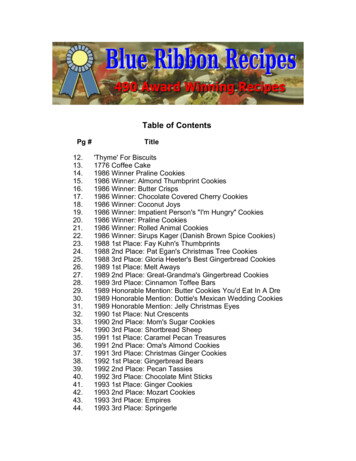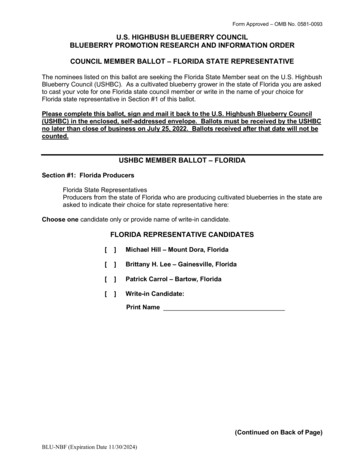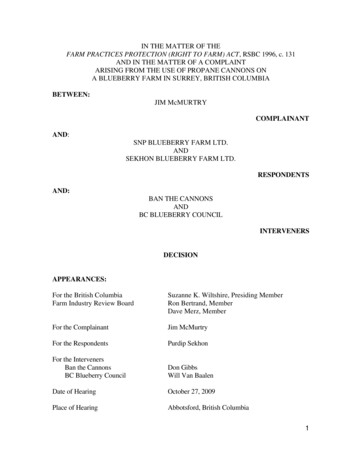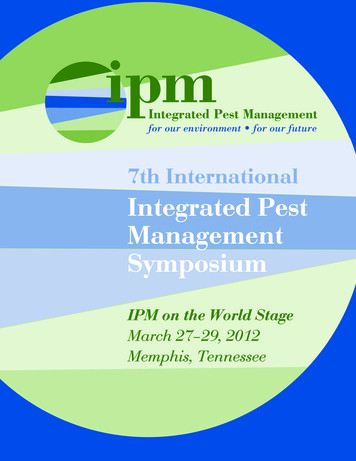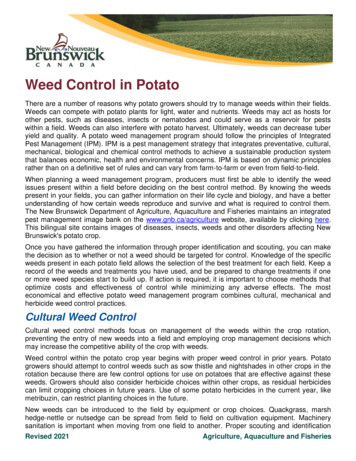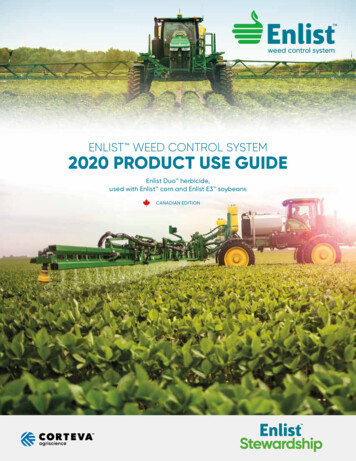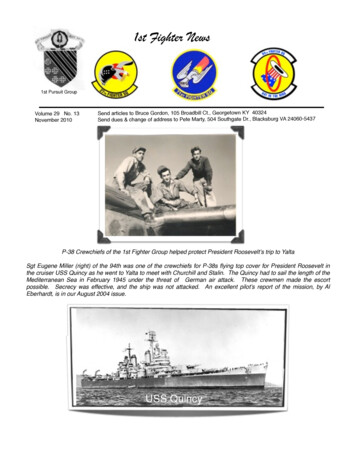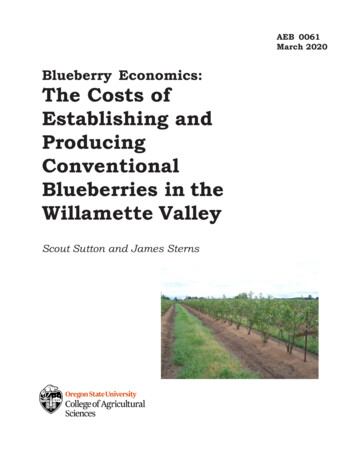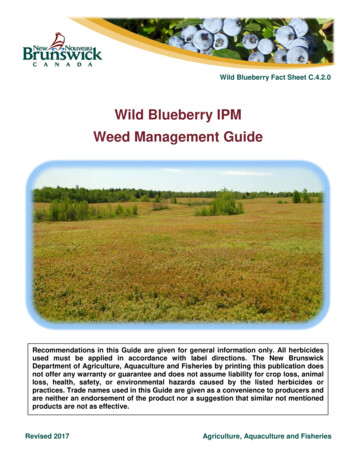
Transcription
Wild Blueberry Fact Sheet C.4.2.0Wild Blueberry IPMWeed Management GuideRecommendations in this Guide are given for general information only. All herbicidesused must be applied in accordance with label directions. The New BrunswickDepartment of Agriculture, Aquaculture and Fisheries by printing this publication doesnot offer any warranty or guarantee and does not assume liability for crop loss, animalloss, health, safety, or environmental hazards caused by the listed herbicides orpractices. Trade names used in this Guide are given as a convenience to producers andare neither an endorsement of the product nor a suggestion that similar not mentionedproducts are not as effective.Revised 2017Agriculture, Aquaculture and Fisheries
Wild Blueberry Fact Sheet C.4.2.0Table of ContentsIntroduction . 3Components of an Integrated Weed Management Program . 3I. Weed Identification and Biology . 3II. Scouting and Weed Mapping . 5III. Weed Thresholds and Action Levels . 5IV. Control Methods . 6Herbicide Use . 91. Methods of Application . 92. Sprayer Calibration . 103. Best Management Practices. 114. Tank Mixing . 12Notes on Herbicides Registered for Use on Wild Blueberry . 131. Authority 480 (sulfentrazone). 132. Callisto 480 SC (mesotrione). 143. Casoron G-4 (dichlobenil) . 154. Chateau (flumioxazin) . 155. Dicamba (Banvel II, Hawkeye, Oracle). 166. Garlon (triclopyr) . 177. Glyphosate (Roundup, etc.) . 178. Ignite SN Herbicide (glufosinate) . 199. Kerb SC (propyzamide) . 2010. Lontrel 360 EC (clopyralid) . 2011. Option 2.25 OD UAN (foramsulfuron) . 2012. Poast Ultra Merge (sethoxydim) . 2113. Princep Nine-T (simazine) . 2214. Sinbar WDG (terbacil) . 2215. Spartan Agral 90 (tribenuron methyl) . 2216. Ultim 75 DF Agral 90 (nicosulfuron/rimsulfuron) . 2317. Velpar DF and Pronone 10G (hexazinone) . 2418. Venture L (fluazifop-p-butyl) . 26Notes on Herbicide Tables . 27TablesTable 1. Herbicide Effect on Common Blueberry Field Weeds . 28Table 2. Herbicides Registered for Broadcast Application . 29Table 3. Herbicides Registered for Spot Application . 30Table 4. Additional Information for Herbicides Used on Wild Blueberry . 31Pesticide Emergency Information . 32Helpful Conversions . 32Abbreviations . 32Page 2Agriculture, Aquaculture and Fisheries
Wild Blueberry Fact Sheet C.4.2.0IntroductionThe weed flora in wild blueberry fields is unique compared to that found in other agricultural fields.Producers manage a native perennial crop that grows in low pH soils without associated tillage orcultivation. Weeds which prefer this habitat thrive if not controlled. Weeds can shade and competewith the crop, reduce bud/flower production and yield, reduce quality and can interfere withharvesting. The origin of a field often determines the weed flora. Fields developed from abandonedhayfields or pastures typically have a large number of grasses and herbaceous perennial weeds.Fields developed from woodland often have plants commonly associated with the woodlandundergrowth such as bunchberry, ferns, lambkill, rhodora, and other woody plants and shrubs.A weed survey conducted in the year 2000 recorded more than 250 species in blueberry fields,compared to only 115 species in a 1985 survey. The number of many of the traditional woodyweeds has decreased due to herbicide use, but this has been off-set by greater numbers ofherbaceous annuals and perennials. Not all non-traditional species are considered as significantweed problems but some, like lamb’s quarters and herbicide resistant fescue grasses, have thepotential of becoming major problems. This change in weedy vegetation resulted from herbicideuse, especially hexazinone (Velpar/Pronone). Other contributing factors have been changes inproduction practices that allow weeds to spread and thrive, such as the increased use of fertilizers,increased use of mowing instead of burning for pruning and the use of mechanical harvesters andother equipment that spreads weeds. In the future, growers can expect an increasingly diverseweed flora. It is important to understand the activity and limitations of available weed controloptions and to use herbicides in conjunction with other practices to manage weeds.A blueberry weed management program should follow the principles of Integrated PestManagement (IPM). IPM is a pest management strategy that integrates preventive, cultural,mechanical, biological and chemical control methods to achieve a sustainable production systemthat balances economic, health and environmental concerns. IPM is based on dynamic principlesrather than a definitive set of rules and can vary from farm-to-farm or even from field-to-field. Aweed management program that follows the principles and practices of IPM is often referred to asan integrated weed management (IWM) program.Components of an Integrated Weed Management ProgramI. Weed Identification and BiologyWhen planning a weed management program, blueberry producers must first be able to identifythe weeds present in each of their fields. Most weed guides do not include many of the importantblueberry weeds. The New Brunswick Department of Agriculture, Aquaculture and Fisheriesmaintains an integrated pest management (IPM) image bank on the www.gnb.ca/agriculturewebsite, available directly here. This site contains images of diseases, insects, weeds and otherdisorders affecting New Brunswick's blueberry crop. Most images are available in both low andhigh resolution and the site is completely bilingual. The site can be accessed by three differentmethods: 1) the Browse feature where a pest category and/or crop can be selected to find theappropriate images, 2) the Search feature using a key word search or 3) the Complete Listingshowing all images in the bank. Clients with slower Internet connections should only select lowerresolution images to avoid long download times. Other excellent illustrated publications foridentification of blueberry weeds are: Weeds of Eastern Canadian Blueberry Fields by M.G.Sampson, K.V. McCully and D.L. Sampson. NSAC Bookstore, Truro, N.S. 229 pp or Guided’identification Alliés et Ennemis du Bleuet Nain, by È-C. Desjardins and R. Néron, Centre deRéférence en Agriculture et Agroalimentaire du Québec.Page 3Agriculture, Aquaculture and Fisheries
Wild Blueberry Fact Sheet C.4.2.0Knowing how plants are classified or grouped helps to understand similarities and differencesbetween them. An understanding of the life cycle and the reproductive strategy of weeds is neededin order to use the best approach to their control. Based on life cycle, weeds within wild blueberryfields can be categorized as annuals, biennials or perennials.A) AnnualsAnnuals are becoming increasingly common in blueberry fields. Annuals reproduce only by seedand complete their life cycle in less than one year. They grow rapidly, produce large amounts ofseed and may require control in both the sprout and crop year. Control methods must focus onpreventing annuals from producing and spreading seed. Most annuals found in wild blueberryfields are summer annuals that germinate in the spring, produce flowers and seed and die in latesummer or fall. These include such weeds as lamb’s quarters, hemp-nettle, cow wheat and witchgrass. There are also a few winter annuals found in blueberry fields. Winter annuals germinate inthe fall and then over-winter in a seedling or rosette stage. They produce flowers and seeds thefollowing summer and then die. Winter annuals include such weeds as common chickweed andCanada fleabane.B) BiennialsBiennials complete their life cycle in two years. They produce a low-growing rosette of basal leaveswith a taproot that over-winters. Biennials ‘bolt’ to produce a flowering stalk, set seed and die in thesecond year. Examples include yellow evening-primrose, wild carrot and meadow goat’s-beard.Biennials are also becoming increasingly common.C) PerennialsPerennial weeds are the most common in blueberry fields and generally more difficult to control.They live for more than two years and can be either herbaceous or woody. Perennial weeds mayreproduce primarily by seed (daisy); by both seed and vegetative means (sheep sorrel); orprimarily by vegetative means (bunchberry). Many perennial weeds grow in the same manner asthe blueberry plant. Therefore, some of the production practices that promote blueberry growth(like pruning) also promote the growth of these weeds. Perennials which are low growing andspread vegetatively by interconnected underground root systems are the most difficult to controland cannot be controlled by hand-weeding. Some perennials can be controlled with selective ornon selective herbicides, but for many, there are no satisfactory controls.Annuals, biennials and perennials can be grouped in other ways. Flowering plants can be broadlyclassified as dicots (broadleaves) and monocots. There are also primitive plants that do notproduce flowers. Plants can also be grouped into herbaceous (non-woody) and woody species.1) Flowering PlantsFlowering plants produce seed and can be divided into broadleaved species or dicots (with twoseed leaves) and monocots (with one seed leaf). Dicot leaves have a branching network of veinsand flowers with petals, although these can be inconspicuous, as shown by alders or lamb’squarters. Monocots have leaves with parallel veins. With the exception of lilies and related plants,monocots have flowering heads of many small, reduced flowers (or florets) without petals thatproduce a single seed. Monocots include grasses, that are annuals or perennials with jointedstems that are usually hollow and round in cross section; sedges, which are usually perennialplants that form tussocks with leaves that are V-shaped and stems that are triangular in crosssection; and rushes, that are annuals and perennials with tussocks of needle-like leaves that areround, jointless and filled with a whitish pith in cross section.Page 4Agriculture, Aquaculture and Fisheries
Wild Blueberry Fact Sheet C.4.2.02) Non-flowering PlantsThere are also primitive, non-flowering plants that reproduce by microscopic spores that includeferns, horsetails and mosses. Ferns, with stalks and fronds, and horsetails, with narrow leaves inwhorls at joints of hollow stems, both spread by underground rhizomes and are difficult to control.Mosses are tolerant to most herbicides but may be suppressed by fire.II. Scouting and Weed MappingScouting and proper weed identification are the foundation of any integrated weed managementprogram. Scouting involves walking fields in a pattern (e.g. “W” pattern) thereby allowingmonitoring for potential weed problems over the entire field. Scouting provides an opportunity toevaluate weed control programs and to look for any herbicide injury. Scouting also provides anopportunity to identify and target new invasive weed species that have the potential to becomeserious weed problems in the future. Scouting results can be compiled into weed maps to highlightthe locations of different weed species. Mapping for weeds from year-to-year is helpful inmonitoring changes in weed species, weed densities, distribution, as well as providing anopportunity to plan your future weed control strategy. The management strategy must target thedominant weeds and prevent the spread of others.The following should be documented when scouting and mapping: the weed species and its life cycle (annual, biennial, perennial); the size or growth stage of the weed (seedling, small, medium, large, flowering, seedformed, seed dropped); the density of the weed (counts or categorize as low, medium, high); the distribution (uncommon, scattered throughout, a few patches, numerous patches,common throughout; or estimate the percent blueberry field covered per weed species); the location of the weed infestations on a field map; the date of scouting.Weed scouting in sprout fields should be done:a) just before blueberry emergence to monitor for bunchberry presence and growth stage;b) soon after blueberry emergence to monitor for potential grass problems;c) late June - early July for weeds growing above the blueberry plants that would besusceptible to wiping treatments;d) late summer-early fall for wiping and evaluating the current year’s weed control program andalso for planning next year’s weed control program.Weed scouting in crop fields should be done:a) before blueberry buds swell to determine if Velpar or Callisto applications are required;b) mid-May to mid-June to scout for grasses;c) mid-July to harvest to determine presence, densities and location of weeds for falltreatments or next year’s weed control program.Special note should be made of weeds that appear to be increasing significantly in distribution anddensity or any new weeds. For example, burnweed has been noted in greater abundance in manyNew Brunswick fields. Weeds which may be undesirable for reasons other than competition shouldalso be noted. Examples include weeds flowering during pollination, weeds known as alternatehosts for insects or diseases, or weeds which can interfere with harvesting.III. Weed Thresholds and Action LevelsWeed thresholds have not been determined for New Brunswick blueberry fields. As a result, thedecision to target a weed for control must be based on knowledge of the weed within your farmingPage 5Agriculture, Aquaculture and Fisheries
Wild Blueberry Fact Sheet C.4.2.0system. From a strictly economic perspective, there is no reason to apply control measures unlessthe weed population inflicts crop damage greater than the cost of the control measure. To makeknowledgeable decisions, growers must scout and monitor their fields and continuously observeweeds and evaluate their effect on the crop. Decisions to control weeds may be made even whenthe cost of control is greater than the losses resulting from weed competition. For example, weedsmay have to be controlled despite low densities when they interfere with harvest, act as alternatehosts for insect pests or diseases, attract bees during pollination, or if they have a high potential tocause future problems if not controlled.IV. Control MethodsWith the information gathered through scouting and the knowledge about the weeds present inyour fields, you can make the decision as to whether or not a weed should be targeted for control.If action is warranted, it is important to choose the methods that optimize costs and effectiveness,while minimizing potentially adverse effects. The most economical and effective blueberry weedmanagement programs combine preventive, biological, cultural, mechanical and chemicalpractices within an integrated system.A) PreventivePreventive weed control includes all practices that prevent the introduction and spread of weedsinto a blueberry field. It is important to be aware of activities which can introduce new weeds andtry to prevent the weeds from being introduced. This will help minimize the build-up and spread ofnew weed introductions.An important preventive practice is to clean equipment between fields. This is important as weedseeds and other plant parts can attach to equipment and soil and be transported by farmequipment. This is a particular problem with mowers, wipers and harvesters. Recent wild blueberryresearch has determined that 200,000 to 400,000 weed seeds could be found on individualblueberry harvesters. All equipment, including tractors, land levelling equipment and berry boxes,should be cleaned. Seed dispersal within and between fields can be limited by avoiding equipmentoperation though dense weed patches during peak periods of seed drop.Limiting seed production will also help prevent weeds from spreading. Keeping weeds undercontrol in ditches, field edges, and roadsides can minimize the introduction of new problem weeds.Weeds can also be introduced into blueberry fields through the use of weedy straw used forburning. It is critical that growers obtain as weed-free straw as possible. Purchase straw from areputable source and, if possible, visit the grain field before harvest to check for weeds.B) CulturalCultural practices that encourage a vigorous, dense and healthy crop help to reduce weedpressures as a result of less bare ground being exposed. The use of wood chips, sawdust or barkmulch can reduce weed problems and encourage clone expansion into bare areas. Bare areas canalso be planted with blueberry plants to increase crop cover. The presence of some grasses,especially in bare spots, reduces invasion of broadleaved weeds and encourages blueberryexpansion.C) FertilityWild blueberries are adapted to grow and produce a crop on soil that is considered, by mostagricultural specialists, to be poor in fertility. Plants have a requirement for nutrients from the soil(nitrogen, phosphorus and potassium, among others). Blueberries have a number of adaptationswhich allow them to thrive in this environment. Weeds are generally better adapted to respond toapplied fertilizer than are blueberries. Excessive fertilizer rates that promote weed growth andPage 6Agriculture, Aquaculture and Fisheries
Wild Blueberry Fact Sheet C.4.2.0vigour should be avoided. Proper fertilizer rates should coincide with adequate weed control tomaximize the benefit from each of these inputs. A reliable tool to determine fertility levels is leaftissue analysis, outlined in this fact sheet.Blueberries are adapted to a low pH environment, with a relatively low pH near 4 to 4.5. Manyweeds, especially annuals and grass species, are not adapted to these conditions. More foresttype species, like lambkill and bunchberry, will not be affected by lowering the pH of the soil.Sulphur application can reduce the availability of soil nutrients for the weeds but allows theblueberries to grow because they are well adapted to acid soil. Approximately 112 kg/ha (100lb/acre) of sulphur is required for a reduction of 0.1 pH unit. Do not apply more than 1120 kg/ha(1000 lb/ac) of sulphur in any given year. Application should not occur when the ground issaturated or injury to blueberries could result. Change in pH may take several years to becompleted, with limited results soon after application.D) BiologicalBiological weed control is the deliberate use of highly selective enemies to reduce the populationof a target weed to an acceptable level. In Atlantic Canada, there have been releases of eitherinsects or pathogens against some weed species, including St. John’s wort, Canada thistle,perennial sowthistle and toadflax. Biological control is generally most effective on introduced, nonnative species in relatively undisturbed, pesticide-free agricultural habitats like pastures andrangelands. Naturally occurring disease epidemics have been observed for St. John’s wort andbracken fern in blueberry fields, giving significant control in some years. The use of insecticidesand fungicides as production practices within blueberry fields also makes the use of insects andpathogens as biological control agents more challenging. The prospect for biological weed controlin wild blueberry is limited.E) MechanicalMechanical methods of weed control include such practices as hand-pulling, pruning(mowing/burn) and clipping.1. Hand-pullingHand-pulling is one of the oldest methods of weed control and is most effective against annuals,biennials and perennial seedlings. Established perennials can only be controlled effectively if theentire root system is removed. This is not possible, in most instances, although hand-pullingperennials can be effective in preventing seed production. If fields have both flowering and nonflowering weeds, flowering weeds should be removed first in order to prevent seed formation. It isalso important to remove pulled weeds from the field, as many can still produce viable seed whenlying on the soil surface. Hand-pulling is easier when the soil is wet.2. Pruning (mow/burn)The main purpose of pruning is to rejuvenate blueberry plants but it also aids in control of someweeds. Burning will control coniferous species and some shallow rooted grasses. The top growthof many woody and herbaceous perennials is generally killed by burning but underground parts resprout. Burning also reduces the return of many weed seeds from mature plants to the soil, andwill kill many of the weed seeds present near the soil surface. Unfortunately, most burningoperations provide only partial or erratic control results. Mowing as a pruning method may givesome short-term suppression of perennial weeds and is generally not recommended as the solemethod of control. Weeds must be mowed or cut several times during the season to ensuresuppression. Species such as maple, birch and willow should be cut back to the ground level.Regrowth from the roots is common and frequently results in additional cuttings. Burning orPage 7Agriculture, Aquaculture and Fisheries
Wild Blueberry Fact Sheet C.4.2.0mowing alone may promote growth of many perennial weeds with extensive underground rootsystems by releasing apical dominance.3. Selective mid-season clippingClipping the tops off weeds before seeds ripen prevents seed formation and helps reduce futureweed problems. Clipping of species in June, July and August for a few seasons may help suppressweeds to acceptable levels. Clipping weeds every mid-summer has also been found to help controlor suppress bracken fern, bayberry, Prunus spp., wild rose, and other weeds. Bracken fern shouldbe cut just as the fronds unfold, at least two times, at four-to-six week intervals. Flowering weedsshould be clipped before weeds which have not yet flowered. For weeds growing above theblueberry canopy, selective clipping can be performed with “whipper-snippers” or other similarequipment. Alternatively, non-woody weeds can be clipped through whipping. Hand clippers canalso be used to target individual low growing weeds, such as sweet fern or lambkill. Clipping islabour intensive and does not generally result in permanent control.F) ChemicalThe use of herbicides to control weeds in blueberry fields is an important component of anintegrated weed management program. Herbicides must be used responsibly and judiciously andas just one component within an overall program. Herbicides cannot be used as a cure-all for poormanagement. No single herbicide or combination of herbicides will control every weed within ablueberry field. Furthermore, excessive weed control that results in long-term bare ground shouldbe avoided as this practice leads to soil erosion and impairs blueberry clone expansion.Herbicides used within blueberry fields are either selective or nonselective. Following labelled ratesand recommendations, selective herbicides control specific weeds without significantly injuringblueberry plants. Some selective herbicides (e.g. Velpar) are only safe to use at prescribed ratesand times of application. If excessive rates are applied they are no longer selective and can causesevere crop injury. Nonselective herbicides kill both weeds and crop plants (e.g. glyphosate) andtherefore caution must be exercised when applying them. Blueberry herbicides are applied eitherpre-emergence (applied before any blueberry plant or weed foliage emerges); or post emergence(applied after blueberry plant and weed foliage has emerged). Pre-emergence herbicides provideresidual control, whereas post emergence treatments provide little or no residual control. To keepfields relatively clean, growers need both a “base program” and a “clean-up program”. The baseprogram refers to the primary method relied on to control most weeds. For blueberry growers,Velpar is relied on most frequently to provide this base level of weed control. The clean-upprogram relies on herbicides such as Callisto, Ultim, Venture L, Poast Ultra, Spartan, Roundup,Lontrel or Banvel II to target specific weeds that escape the base program.Even when label instructions are followed, not all weeds will be controlled. Each herbicide controlsonly specific weed species, and if timing and rates are not followed, control may be poor. Inaddition, other factors can also reduce weed control. For example, if heavy rains follow preemergence applications on sandy soils, some herbicides may leach away from the weed seedgermination zone. Likewise for post emergence herbicides, if rain-free periods are not respected,control can be reduced. A pre-emergence herbicide may not be effective if labelled weeds haveemerged before herbicide application. If emerged weeds are too large, control with postemergence herbicides will be reduced. Control from herbicides can also be reduced if weeds areunder stress. For example, drought stress can cause weeds to form thicker layers of wax on leafsurfaces, thereby reducing herbicide uptake.Page 8Agriculture, Aquaculture and Fisheries
Wild Blueberry Fact Sheet C.4.2.0Herbicide Use1. Methods of ApplicationThere are several methods of applying herbicides, depending on the properties of the herbicideand target weed. The label gives detailed instructions on mixing and application of each productand should be carefully followed to ensure applications are safe and effective. The following givesgeneral information on methods of applying the approved herbicides discussed in Notes onHerbicides Registered for Use in Wild Blueberry.A) Overall Broadcast SprayOverall broadcast spraying involves the use of boom sprayers to apply herbicides uniformly overentire fields or large areas. An overall broadcast spray is recommended for treating areas with auniform rate of herbicide, such as pre-emergence applications of Velpar in the spring of the sproutyear. Broadcast applications can also be made to large infestations of some species, such assweet fern or lambkill, to treat them in the fall of the crop year with Banvel II. Pronone 10G can alsobe applied as a broadcast treatment by using a granular applicator such as a Vicon spreader. Toapply the herbicides at the recommended rate, the equipment must be calibrated and in properworking order. Avoid irregular spray applications by using flagging tape, foam markers, appropriatedyes or GPS systems as guides.B) Directed Spot SpraysThe objective of directed spot spraying is to apply herbicides to the weed foliage while avoidingcontact with the blueberry foliage. Spot sprays are applied with either backpack or handheldsprayers or by operating a handgun from a line connected to a tractor-mounted sprayer.Depending on the product used and the time of application, blueberry plants can be injured orkilled if the foliage is sprayed. Applications are often made in the summer of the sprout year, andcan result in crop injury. Many species such as alders, sweet-fern, bayberry, lambkill andblackberry retain their leaves in a viable condition longer than the harvested blueberries.Treatment in the fall after blueberry leaf drop helps to reduce the potential for crop injury.Herbicide applications to fully expanded leaves of brush species can be useful where there arelimited numbers of escaped brush species. Unless otherwise stated on the label, applicationsshould be limited to bushes that are less than 2 meters i
Wild Blueberry Fact Sheet C.4.2.0 . Revised 2017 Agriculture, Aquaculture and Fisheries . Wild Blueberry IPM . . rather than a definitive set of rules and can vary from farm-to-farm or even from fieldto-field. A - weed management program that follows the principles and practices of IPM is often referred to as an integrated weed management .
